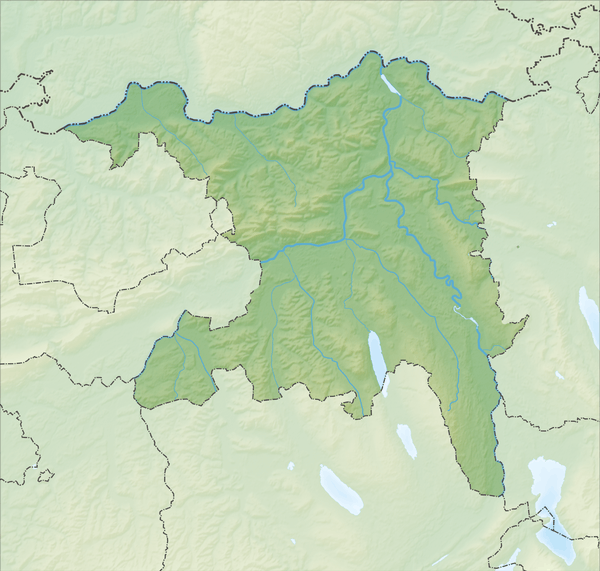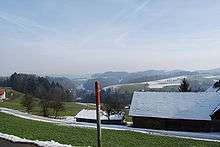Schlossrued
Schlossrued is a municipality in the district of Kulm in the canton of Aargau in Switzerland.
Schlossrued | |
|---|---|
_130.jpg) | |
 Coat of arms | |
Location of Schlossrued 
| |
 Schlossrued  Schlossrued | |
| Coordinates: 47°18′N 8°06′E | |
| Country | Switzerland |
| Canton | Aargau |
| District | Kulm |
| Area | |
| • Total | 7.25 km2 (2.80 sq mi) |
| Elevation | 499 m (1,637 ft) |
| Population (2018-12-31)[2] | |
| • Total | 838 |
| • Density | 120/km2 (300/sq mi) |
| Postal code | 5044 |
| SFOS number | 4142 |
| Surrounded by | Kirchleerau, Oberkulm, Schmiedrued, Schöftland, Staffelbach, Unterkulm |
| Website | www SFSO statistics |
Geography

Schlossrued has an area, as of 2009, of 7.22 square kilometers (2.79 sq mi). Of this area, 4.41 square kilometers (1.70 sq mi) or 61.1% is used for agricultural purposes, while 2.26 square kilometers (0.87 sq mi) or 31.3% is forested. Of the rest of the land, 0.57 square kilometers (0.22 sq mi) or 7.9% is settled (buildings or roads), 0.02 km2 (4.9 acres) or 0.3% is either rivers or lakes.[3]
Of the built up area, housing and buildings made up 3.9% and transportation infrastructure made up 3.0%. 28.0% of the total land area is heavily forested and 3.3% is covered with orchards or small clusters of trees. Of the agricultural land, 16.6% is used for growing crops and 41.7% is pastures, while 2.8% is used for orchards or vine crops. All the water in the municipality is in rivers and streams.[3]
Coat of arms
The blazon of the municipal coat of arms is Azure a Tower embattled Argent roofed Gules issuant from Coupeaux Vert and in chief two Oars of the second in Saltire and between them in chief a Mullet of the same[4]
Demographics
Schlossrued has a population (as of December 2018) of 838[5] As of June 2009, 6.9% of the population are foreign nationals.[6] Over the last 10 years (1997–2007) the population has changed at a rate of -7.1%. Most of the population (as of 2000) speaks German (96.2%), with Serbo-Croatian being second most common ( 0.9%) and Albanian being third ( 0.6%).[7]
The age distribution, as of 2008, in Schlossrued is; 77 children or 8.8% of the population are between 0 and 9 years old and 136 teenagers or 15.6% are between 10 and 19. Of the adult population, 86 people or 9.8% of the population are between 20 and 29 years old. 107 people or 12.2% are between 30 and 39, 159 people or 18.2% are between 40 and 49, and 129 people or 14.8% are between 50 and 59. The senior population distribution is 73 people or 8.4% of the population are between 60 and 69 years old, 75 people or 8.6% are between 70 and 79, there are 31 people or 3.5% who are between 80 and 89,and there is 1 person who is between 90 and older.[8]
As of 2000, there were 20 homes with 1 or 2 persons in the household, 118 homes with 3 or 4 persons in the household, and 171 homes with 5 or more persons in the household. The average number of people per household was 2.76 individuals.[9] As of 2000, there were 321 private households (homes and apartments) in the municipality, and an average of 2.8 persons per household.[7] In 2008 there were 141 single family homes (or 41.0% of the total) out of a total of 344 homes and apartments.[10] There were a total of 4 empty apartments for a 1.2% vacancy rate.[10] As of 2007, the construction rate of new housing units was 1.2 new units per 1000 residents.[7]
In the 2007 federal election the most popular party was the SVP which received 54.9% of the vote. The next three most popular parties were the SP (11.7%), the CSP (8.5%) and the Green Party (7%).[7]
In Schlossrued about 66.9% of the population (between age 25-64) have completed either non-mandatory upper secondary education or additional higher education (either university or a Fachhochschule).[7] Of the school age population (in the 2008/2009 school year), there are 74 students attending primary school, there are 73 students attending secondary school in the municipality.[9]
The historical population is given in the following table:[8]
| Year | Pop. | ±% |
|---|---|---|
| 1975 | 842 | — |
| 1980 | 857 | +1.8% |
| 1990 | 894 | +4.3% |
| 2000 | 913 | +2.1% |
Economy
As of 2007, Schlossrued had an unemployment rate of 1.59%. As of 2005, there were 123 people employed in the primary economic sector and about 46 businesses involved in this sector. 97 people are employed in the secondary sector and there are 7 businesses in this sector. 79 people are employed in the tertiary sector, with 27 businesses in this sector.[7]
In 2000 there were 455 workers who lived in the municipality. Of these, 343 or about 75.4% of the residents worked outside Schlossrued while 88 people commuted into the municipality for work. There were a total of 200 jobs (of at least 6 hours per week) in the municipality.[11] Of the working population, 7.2% used public transportation to get to work, and 51.6% used a private car.[7]
Religion
From the 2000 census, 123 or 13.6% were Roman Catholic, while 661 or 73.2% belonged to the Swiss Reformed Church. Of the rest of the population, there was 1 individual who belonged to the Christian Catholic faith.[9]
References
- "Arealstatistik Standard - Gemeinden nach 4 Hauptbereichen". Federal Statistical Office. Retrieved 13 January 2019.
- "Bilanz der ständigen Wohnbevölkerung nach institutionellen Gliederungen, Staatsangehörigkeit (Kategorie), Geschlecht und demographischen Komponenten". Federal Statistical Office. Retrieved 12 January 2019.
- Swiss Federal Statistical Office-Land Use Statistics 2009 data (in German) accessed 25 March 2010
- Flags of the World.com accessed 30-April-2010
- Swiss Federal Statistical Office - STAT-TAB, online database – Ständige und nichtständige Wohnbevölkerung nach institutionellen Gliederungen, Geburtsort und Staatsangehörigkeit (in German) accessed 23 September 2019
- Statistical Department of Canton Aargau -Bereich 01 -Bevölkerung (in German) accessed 20 January 2010
- Swiss Federal Statistical Office accessed 30-April-2010
- Statistical Department of Canton Aargau -Bevölkerungsdaten für den Kanton Aargau und die Gemeinden (Archiv) (in German) accessed 20 January 2010
- Statistical Department of Canton Aargau - Aargauer Zahlen 2009 (in German) accessed 20 January 2010
- Statistical Department of Canton Aargau (in German) accessed 20 January 2010
- Statistical Department of Canton Aargau-Bereich 11 Verkehr und Nachrichtenwesen (in German) accessed 21 January 2010